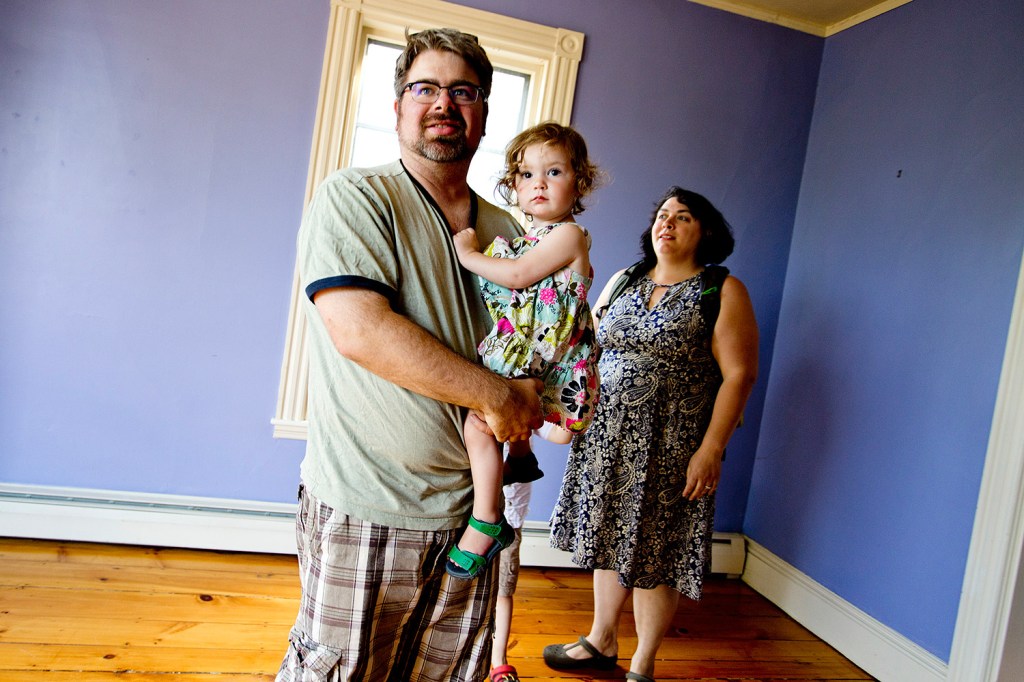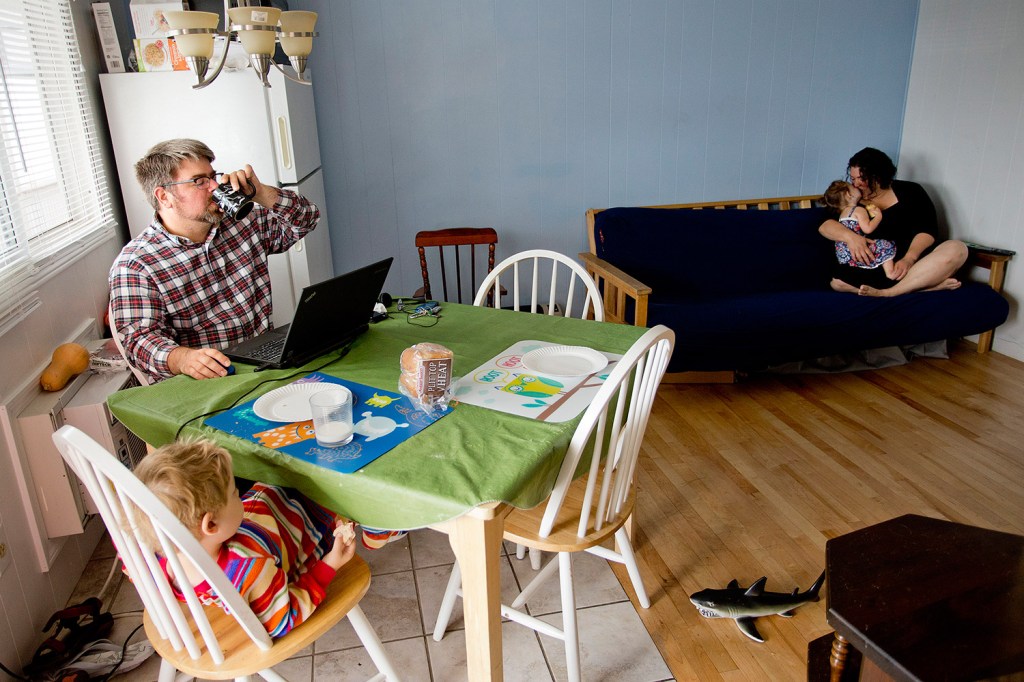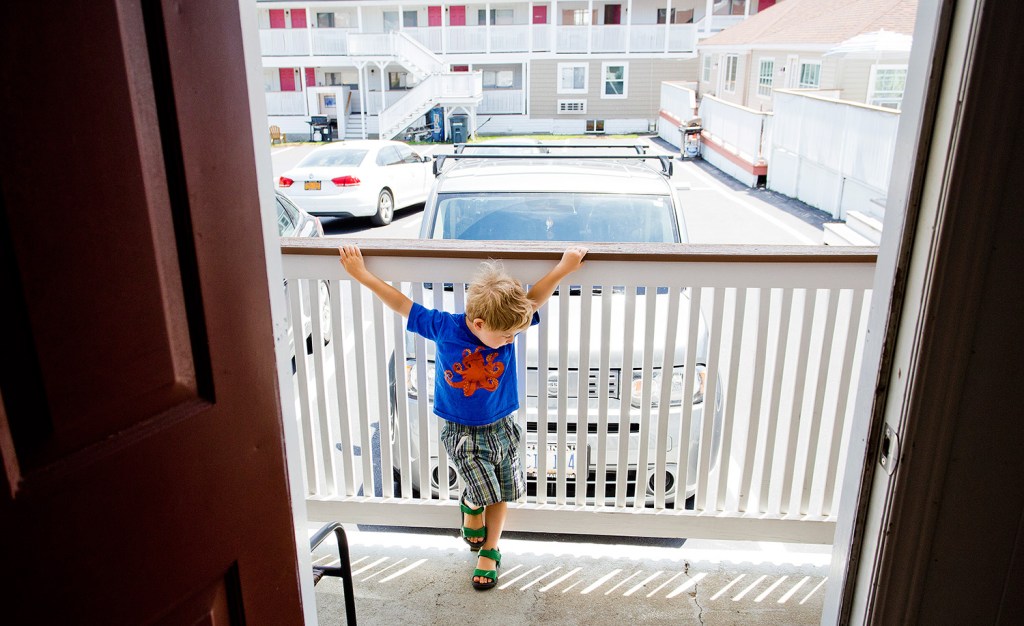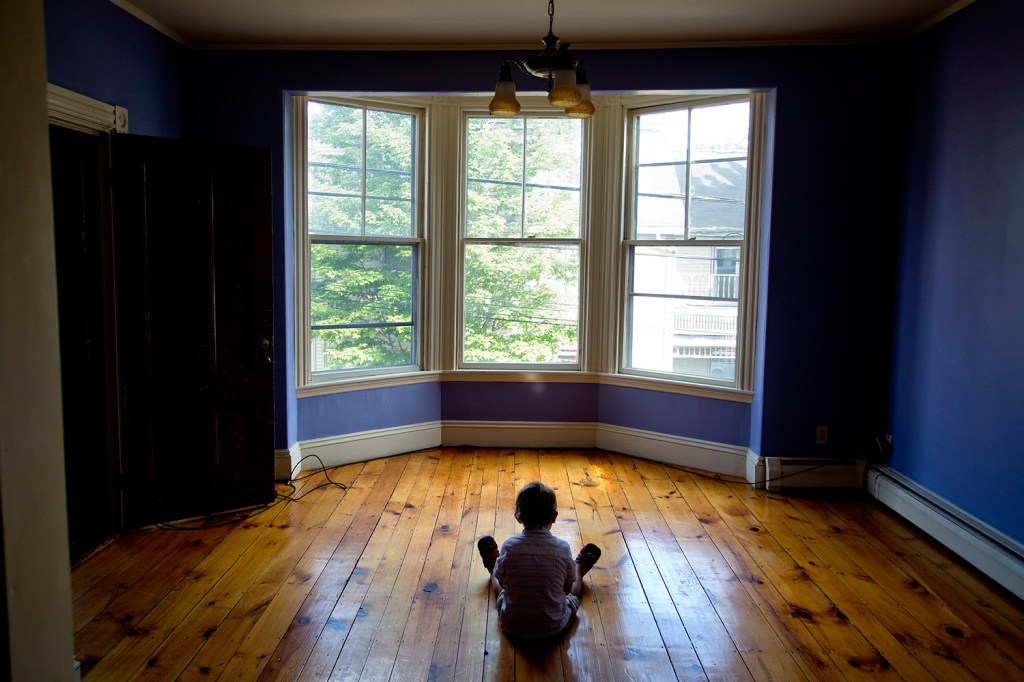A
fter eight years of living outside Columbus, Ohio, the Lavelles were looking for a change of scenery.
Their new home, they decided, should be a coastal city with access to the outdoors and a low crime rate. And it should be affordable for their family of four living on a computer security salary, a job that can be done from anywhere. Sight unseen, they settled on Portland, which had everything they wanted plus a reputable food scene they’d read about online.
But nothing prepared the Lavelles for the challenge of finding an apartment to rent.
The first warning sign came when landlords wouldn’t even talk to them until they arrived in town. Then, after the couple sold their Ohio home in May and moved with their two young children into an Old Orchard Beach motel room, they still got few responses when following up on rental ads.
One morning, they packed up the two kids and went to Portland’s Munjoy Hill, joining other prospective tenants at an open house for a new apartment listing. The two-bedroom unit was smaller and more expensive than they wanted at $1,550 a month, but it was a real possibility, they thought – until they heard another woman at the showing offer to pay the whole first year’s rent, upfront. They didn’t bother to pay the nonrefundable application fee and left.
“This has been far more difficult than we expected,” Sean Lavelle said.
The Lavelles are among a growing number of people from away who are attracted to the quality and pace of life in Portland, where the wealth of culture is out of proportion with the city’s population – and its rental housing stock.
Portland’s rise in popularity has coincided with a national shift away from homeownership in the suburbs and toward urban living and monthly rent payments. Both trends follow a long period of little to no development of new housing in the city, combining to turn that demand into a vacancy rate of near zero and a market that is pushing the cost of apartments well above what is considered affordable to the typical Portland renter.
The Maine Sunday Telegram/Portland Press Herald spent much of the past year talking to renters, landlords and housing officials and analyzing data on the changing demographics and rising rental prices in Portland’s neighborhoods.
What it found is a surging and unforgiving market that’s forcing renters to out-hustle each other, hand over more of their paychecks, move out of the city and, in some cases, sleep in campers or homeless shelters. Those changes are reshaping the landscape and character of the city in ways that will last long after the market finally cools down.
Interactive: Christian MilNeil
A
verage market rents for a two-bedroom apartment in Portland have shot up 40 percent in the past five years – even after adjusting for inflation – and the trend accelerated in the past two years. A national report on rents in May showed that the yearly increase in the Portland region was the second-highest of any metropolitan area in the country.
A Telegram/Press Herald analysis of apartment listings in September and October found the average two-bedroom apartment in Portland was renting for $1,560, nearly 20 percent more than the average market price of $1,310 during 2014, according to an annual survey by the Maine State Housing Authority. The average two-bedroom on Munjoy Hill – the hottest of Portland’s rental neighborhoods – hit the market at $1,829 a month.
That spike in rents has occurred even as renter incomes in the city have fallen, according to the newspaper’s analysis.
The median income for a renter household in Portland dropped to a nine-year low of $30,601 in 2014, down more than 12 percent from a peak of $34,902 in 2010, according to data prepared for the state housing authority by Claritas, a private market research company. When adjusted for inflation, the median renter household earned less in 2014 than in any year since at least 2000. That decline has occurred as incomes of homeowner households have risen.
The combination of rising rents and falling median incomes has created a yawning affordability gap.
The median renter household would need to spend 59 percent of its income on the average two-bedroom coming on the market in Portland this fall. Housing is considered to be affordable when a household spends 30 percent or less of its income on a place to live.

T
he tight market and rising costs are having a widespread effect throughout the city, where more than half of the 66,669 residents are renters. For example:
• The growing affordability gap in Portland’s rental market coincides with a so-called hollowing out of the population in Maine’s most urban community, meaning the middle class is shrinking while the number of rich and poor residents grows. Some middle-income renters are moving to the suburbs, where buying a house is often less expensive than paying rent in Portland. And the city’s primary soup kitchen has seen a 50 percent increase in demand in three years as lower-income residents struggle with rent payments and, in some cases, get priced out of their apartments and forced into homeless shelters.
• The market is accelerating gentrification, most notably on Munjoy Hill, where the number of residents with bachelor’s degrees jumped from just over one-third in 2000 to just under two-thirds in 2013. In the same period, median home values there grew more than anywhere else in the city, transforming Munjoy Hill from a low-end neighborhood to the most expensive rental market and second most expensive place in Portland to buy a house, after the West End.
Interactive: Christian MilNeil
• Employers and city officials are increasingly concerned about the effect on the future workforce, including lower-wage workers less willing or able to commute from more affordable towns. And, although Portland’s quality of life is a valuable recruiting tool for local businesses, workers relocating from out of state are quickly learning that their new lives won’t include a downtown lifestyle and short walk to the office.
• Surrounding communities are feeling the ripple effects, as renters priced out of Portland fill apartments and drive up rents in communities such as South Portland and Biddeford.
• Landlords are taking advantage of the market by charging nonrefundable application fees, asking for larger deposits, raising rents and more aggressively screening candidates to get the best tenants. While some are investing to upgrade housing – sometimes, in the process, forcing tenants out – other landlords continue to neglect properties without having to worry about vacancies, even allowing life-threatening conditions for tenants who have few other options.
• The financial pressures on tenants and the rapid changes in historic neighborhoods have infused Portland politics, which have been dominated by battles over development projects and efforts to save the character of the city.

T
his is not the first time Portland has experienced a rental shortage.
Similar cries about a housing crunch arose in the mid-to-late 1990s, when the focus was on a lack of affordable housing and the effect it was having on homelessness.
Since then, although affordable units have been added to Portland’s peninsula, no solely market-rate projects had been built there for more than two decades until West End Place, a 39-unit apartment building, was completed in 2014. Since then, others have followed suit as developers race to take advantage of the rising number of renters choosing to move to Portland. In all, 862 new housing units – mostly market-rate – had been approved, were under review or were being built as of October.
The intense competition for Portland’s finite supply of apartments appears to be changing who lives in them rather than dramatically adding to the city’s population. Census numbers show an influx of relatively well-heeled outsiders, who appear to be replacing Mainers unable to compete for living space.
Since 2000, the city’s population has grown just under 4 percent to 66,669, according to 2014 census data released in September, while the number of native Mainers in Portland has dropped from nearly 60 percent of the city’s population to just under half.
Portlanders who have come from other states are 80 percent more likely to have a graduate or professional degree than Maine-born residents are, and they are 50 percent more likely to have an annual income over $75,000.
To compete for those tenants who can pay higher rents, landlords are renovating their buildings and, in doing so, kicking out the people who live there.
Aziza Comparetto, a disabled veteran in his early 40s, had lived in a one-bedroom apartment in the West End for 2½ years when it was sold in the winter to Port Property Management. The new owner tried to evict him in February, but Comparetto, who is working to earn a bachelor’s degree, convinced the landlord to let him and his dog stay until the semester ended in May.
Since then, they’ve been camping and living out of his car. He receives too much money through his veteran’s benefits to be eligible for housing assistance, but not enough to pay for rent in Portland or a dorm room at the University of Southern Maine.
So, he’s saving up for a battery to run a heater and electric blanket.
A one-bedroom in his former building is now listed at $1,250 – $400 more than he paid.

I
t’s no secret how this happened. Once seen as a hidden gem with a high quality of life at a good price, Portland has attracted national attention for its cultural and recreational amenities and its growing number of restaurants, craft breweries and coffee roasters.
In recent years, it’s been named one of the best places to live by Men’s Journal and Outside Magazine and the foodiest small city by Bon Appetit. It’s one of the best cities for hipsters, according to Travel + Leisure, and for raising a family, according to Parenting Magazine.
There are more food trucks per capita than every major metropolis except Orlando and Miami.
Portland’s appeal also is fueling demand for short-term vacation rentals, a trend that is siphoning apartments out of the less lucrative year-round housing market. Airbnb, for example, lists 250 short-term rentals in Portland, although it’s unclear how many of those were former year-round rentals.
At the same time, national trends are creating more demand for apartments in cities everywhere, including Portland.
Nationally, the number of renters rose from 31 percent of the population to over 33 percent between 2010 and 2013. Portland’s population is just about split between renters and homeowners, but there are signs of change here, too. In 2010, renters had accounted for 48 percent of the population. After inching up year by year, renters surpassed the number of people living in owner-occupied homes in 2013.
Several factors are at play.
The subprime mortgage crisis during the Great Recession resulted in people losing their homes and becoming unable or unwilling to buy again, creating more renters who were most likely to find apartments in urban centers.
Meanwhile, aging baby boomers created a bubble of retirees looking to downsize from the homes where they raised their families and enjoy the convenience of city living.
The trend toward later marriage also has kept more millennials – many of them the children of baby boomers – living in the city longer, although rising rents and low mortgage rates are finally giving them enough financial incentive to choose homeownership, if they can afford it.
Those higher-income renters becoming homeowners may be one of the reasons that average renter incomes in Portland are falling statistically, even as other households are earning more, according to economists with the Maine Department of Labor.
Another possible culprit is that some middle-income jobs are disappearing. Production work is being replaced by automation, and former full-time positions such as filing clerks are no longer needed now that documents are stored electronically, the economists said.
While these trends have increased rents and driven down renter incomes in cities all over the country, Portland’s recent arrival on the national scene as a hip place to live has created a more dramatic change – one that is unsustainable for people already here, and causing sticker shock for those who moved to the city for a simpler life.
In May 2015, data from the Zillow real estate website showed the Portland region’s median rent had risen 17.4 percent from the previous May. That was the second-biggest increase, behind Jackson, Mississippi, among the nation’s 100 largest metropolitan areas, of which Portland is the smallest. The median rent that month – $1,582 – was $8 more than in Philadelphia and $38 less than in Chicago.

T
he effects of the soaring rents are most evident in neighborhoods on and around the Portland peninsula, where renters make up most of the population.
The once-gritty Munjoy Hill has become a magnet for the wealthy and one of the hottest patches of rental real estate in Maine, fueling the rapid citywide increase in market rents. The warehouses of East Bayside have turned into craft breweries drawing the hipster crowd, and Parkside, which still has a reputation as a high-crime neighborhood, is the new hub for apartments on the peninsula that might still be affordable to middle-income workers.
In the heart of the more affluent West End, between Brackett and Emery streets, the most recent U.S. Census data lists the rental vacancy rate at zero.
That’s right where 33-year-old Ivy McGrew’s search was centered when she moved across the country to Portland in March to start a job as a women’s active-apparel designer at L.L. Bean in Freeport.
It was her visits to Portland while interviewing that convinced her to accept the offer. “There’s so much sophistication for such a small city – great restaurants, beautiful neighborhoods,” she said. “I just got romanced by it.”
She also thought it would be a chance to save money. Although she’d be making well above the median renter household income of $30,601, she still had a $500 monthly student loan to pay.
Coming from Hermosa Beach, California, with the ocean and palm trees outside her one-bedroom apartment, she didn’t think it would be a problem finding a larger place in Portland’s West End that was within her budget.

Her sights were on a two-bedroom apartment for under $1,400 a month, with some specifications. Along with needing a cat-friendly place, she wanted off-street parking, laundry facilities in the building and – after years spent living underneath a noisy neighbor – a top-floor unit.
Just two or three years ago, she might have had her pick. McGrew had everything going for her – a salary twice Maine’s median, a relocation coordinator from her new company and a clean background. But she soon found her wish list might be more of a fantasy.
For her first weeks on the job, McGrew spent every lunch break driving from Freeport to Portland to look at apartments. In three weeks, she saw at least 15 places and emailed or called about more than 40 others.
At most showings she was joined by a handful of other people, all of them griping about the difficulty of finding an apartment.
“When I first started looking, I thought, I only want to live in the West End,” McGrew said. “I quickly realized that was not realistic.”
Her price range expanded, too. Near the end of her search, McGrew found herself scrounging to find contact information for past landlords to get the references required to apply for a $1,600-a-month apartment in suburban North Deering – far from the in-town, affordable lifestyle she imagined.
McGrew’s story, however, has a happy ending. She was able to find a top-floor, cat-friendly, two-bedroom apartment on Vaughn Street in the West End for $1,300 a month and moved in at the end of April, about a month after arriving in Portland. The catch: Utilities are not included, and the heating bill was $300 last January.
L
andlords, who are getting bombarded with phone calls as soon as they post a listing, have the luxury of being picky about their tenants.
Many are requiring nonrefundable application fees of $25 per adult – a cost that quickly adds up for people trying to compete for units that come onto the Portland market and then quickly get taken off.
In addition, some landlords are asking for first and last month’s rent, as well as a security deposit, which adds up to a total upfront cost of $4,700 for the median rent.
That quickly prices out people like Wayne Dyer, 37, who lives paycheck-to-paycheck working as a cook in South Portland.
Despite being sober for more than a year, past transgressions have left him with a sketchy criminal and credit history – and he doesn’t think the tattoos on his neck help him either in a market where landlords sometimes invite applicants to open houses before selecting their new tenants.
Dyer, who grew up in Bar Harbor, has lived in Portland since 2002. Until recently, he had an apartment on Munjoy Hill with two roommates, but their habits didn’t jibe with his sober lifestyle, so he decided to move out.
With no car, he needed to be within walking distance of his job or a bus that would take him there.
After couch-surfing in friends’ homes for a couple of months with no luck finding an apartment, he moved back into a halfway house for people in recovery, because it was the only place that would take him. At $160 a week, it wasn’t helping him save any money, although he didn’t say how much he earned.
“I’m 37 years old,” Dyer said. “I just want my own place.”
Working 50 hours a week, that’s something he feels he deserves.
“It just seems impossible. It’s really frustrating,” he said.
The level of desperation has allowed some landlords to neglect their properties without having to worry about filling their apartments – a problem that caught the city’s attention when numerous code violations were discovered after an apartment building fire on Noyes Street killed six young adults last year. That led the city to create a new housing safety office, funded by an annual fee for landlords of $35 per unit.
B
ut in another part of the city budget, it’s taxpayers who are taking the hit for the housing crunch. They’re pouring millions of dollars into the market, whether they know it or not.
Over the past five years, the cost of providing temporary housing to poor people has nearly doubled, and it’s not because there are more participants in the program.
The number of active General Assistance cases in Portland rose from 2,700 to just 2,740 between 2009 and 2014. However, the annual amount spent on rental vouchers for those people increased from $2.7 million to $5.1 million, a jump that the city attributed to the “housing bubble” in an analysis of the General Assistance budget.
Many lower-income residents are also turning to other forms of assistance in order to shift more of their earnings toward rent and avoiding eviction, according to Preble Street, the downtown social service agency that operates a soup kitchen and food pantry, among other programs.
Losing housing also has become a more common reason why people end up in the city’s homeless shelters – and the difficulty of finding a new place is keeping them there.
Donna Yellen, Preble Street’s chief program officer, said it took a month for three staff members responding to every new listing to secure an apartment for one client. For homeless people who are elderly, disabled or working full-time jobs and only have access to the phone at the shelter, she said, it would be much more difficult to find a way out of the shelters.

A
lthough there are no signs that the demand for Portland apartments is subsiding, the city, and the market, have begun to react.
A new city policy requires developers to build some apartments that are affordable to middle-income renters. Officials also are considering whether to regulate short-term rentals, listed on sites such as Airbnb, which could return some apartments that have been used as lodging back into the housing stock.
But those responses pale in comparison to the reaction of the market and the hundreds of new housing units in the process of being approved or built in the city, enough to increase the long-stagnant rental stock by 5 percent. That’s not including the proposed redevelopment of the Portland Co. complex, where there’s a potential for another 400 units along the water on Munjoy Hill.
Former state economist Charles Colgan said the rise in demand and displacement of residents are part of a natural cycle for cities, as tastes and trends change.
“The ultimate effect is the shift back to the suburbs,” he said.
And once the supply increases and urban living loses some appeal, the rents will stop skyrocketing.
What’s harder to predict is how long the current tight market will last, and when it ends, what Portland’s neighborhoods will look like and who will live in them.
T
he Lavelles’ move from Ohio to Portland clearly came in the heat of the market surge.
After the months-long effort to secure a place to rent from Ohio, the unanswered calls and emails from the motel room in Old Orchard and the eye-opening open house on Munjoy Hill, the couple stepped it up.
The afternoon after missing out on the Munjoy Hill two-bedroom, the couple – with their 4-year-old son, Graham, and daughter Mary, almost 2 at the time, in tow – headed to Princeton on Back Cove, a complex where the one available apartment barely had room for the four of them to sleep, let alone a home office. And that evening they looked at another two-bedroom on the East End that was even smaller.
They squeezed through the rooms past other prospective tenants, who were filling out applications as the Lavelles left. The couple hadn’t brought a pen, and even the landlord suggested they look for something bigger.
By the next day, they had set up six more showings, from East Deering to South Portland. This time, they left their motel room with a checkbook in hand.
The first place they saw was a two-bedroom on the West End for $1,450 a month without heat – about $100 more than their mortgage in Ohio.
It was still smaller and more expensive than they originally wanted. But, having learned from experience, they decided to be aggressive and offered to put down a deposit on the spot. They were home.
Three months later, they had already decided they won’t be leaving the area any time soon, although they plan to buy a place with a yard outside Portland when their lease is up.
The constant sight of moving trucks in their neighborhood keeps their apartment-hunting experience fresh in their minds. Friends from out of state are surprised to hear how hard it was to find a place.
But, with a roof securely overhead, there’s nothing they would have done differently, Sean Lavelle said.
“We’re glad we moved here,” he said.
Send questions/comments to the editors.








Comments are no longer available on this story